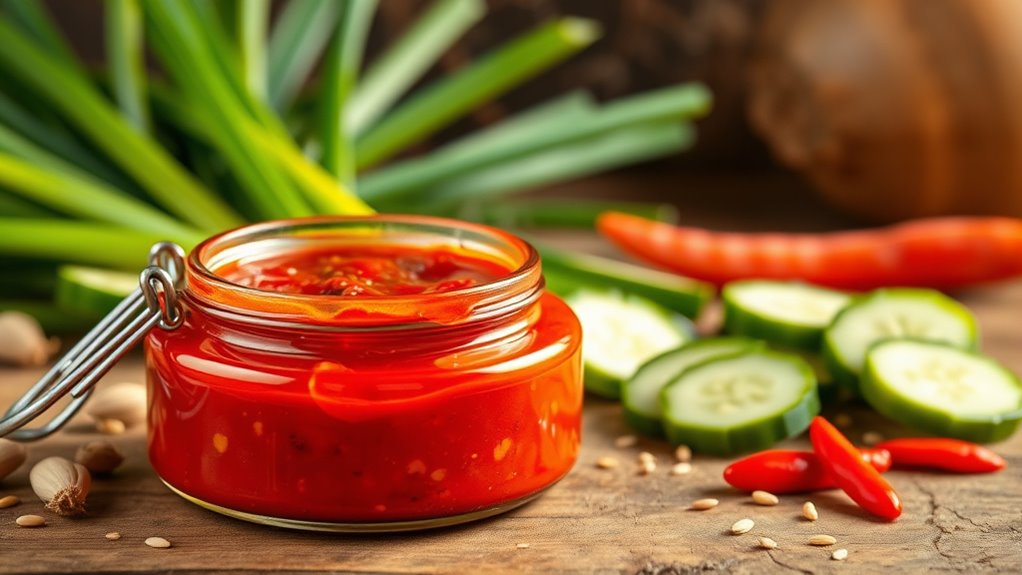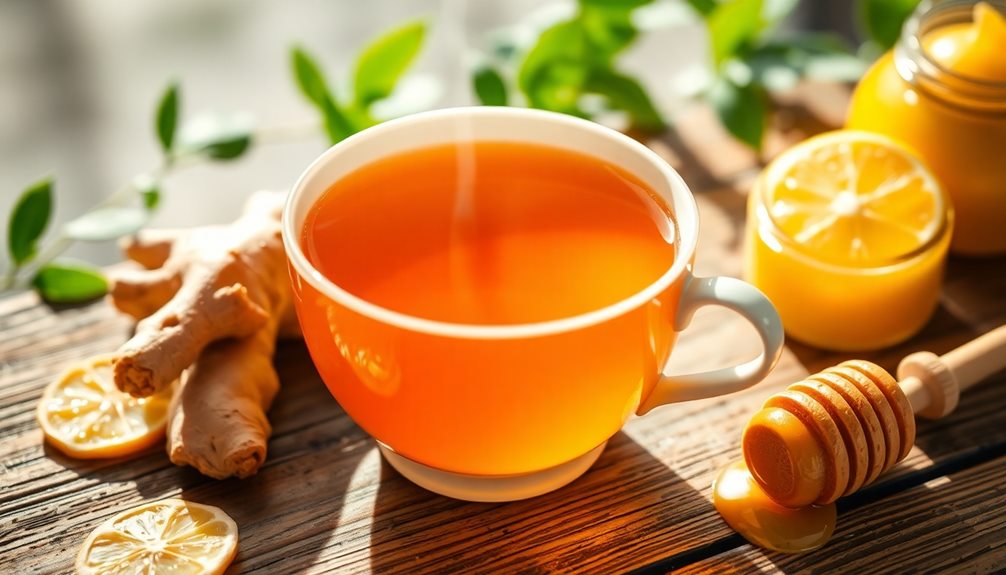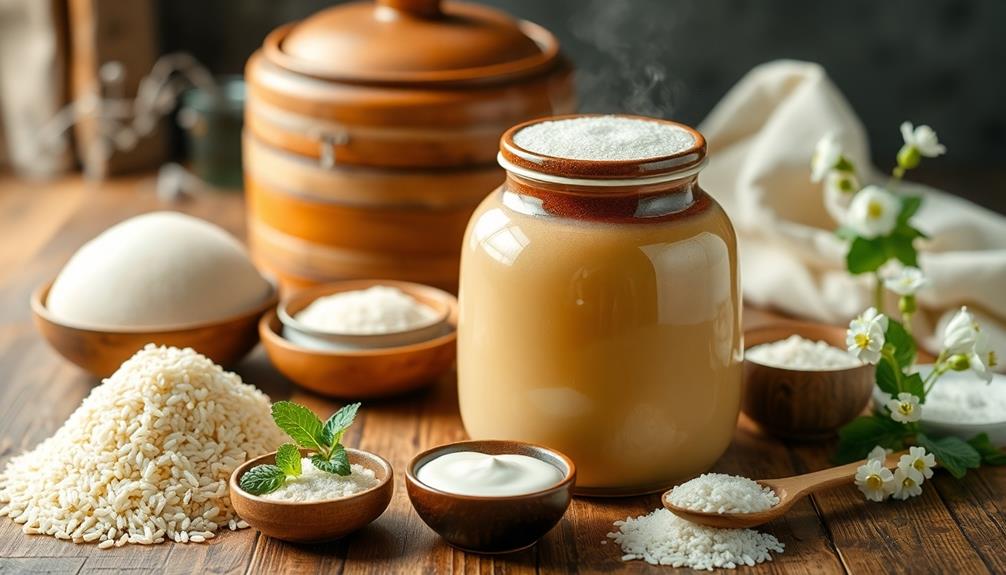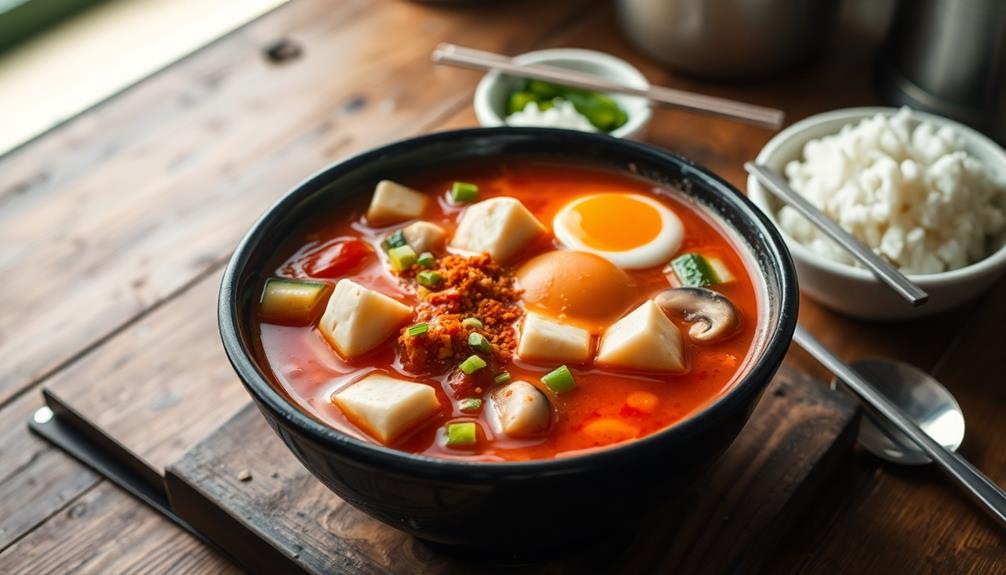Gochujang makes everything taste better because its fermentation process develops deep umami flavors that enhance dish complexity. Microbes break down proteins and starches, creating savory amino acids, especially glutamate, which triggers that satisfying umami sensation. This natural fermentation also adds sweetness, spice, and tang, balancing flavors perfectly. Its long fermentation period allows flavors to mature, giving your dishes richness and depth. Keep exploring, and you’ll discover how this traditional technique transforms ordinary ingredients into extraordinary flavors.
Key Takeaways
- Fermentation in Gochujang produces umami-rich amino acids like glutamate, enhancing savory flavors in dishes.
- The controlled fermentation process deepens its complex flavor profile, balancing spice, sweetness, and saltiness.
- Beneficial microbes from fermentation boost gut health and contribute to the condiment’s distinctive taste.
- Gochujang’s natural umami reduces the need for artificial seasonings, enriching dishes naturally.
- Its layered, full-bodied flavor elevates the taste of soups, stews, marinades, and stir-fries.

Have you ever wondered what makes certain foods taste so rich and savory? The answer often lies in the complex magic of the fermentation process. When ingredients like chili peppers, soybeans, and grains undergo fermentation, they develop deep, umami flavors that can transform any dish. Gochujang, the spicy Korean chili paste, is a perfect example. Its unique flavor profile results from a carefully controlled fermentation process that enhances its taste, making everything it touches more flavorful and satisfying. This process isn’t just about preserving ingredients; it’s about releasing layers of flavor that are impossible to achieve through other means. As the mixture ferments over time, naturally occurring microbes break down proteins and starches, creating amino acids like glutamate—key compounds responsible for umami. This is why Gochujang delivers such a rich, savory kick that elevates soups, stews, marinades, and even snacks, turning simple ingredients into culinary masterpieces.
The fermentation process in Gochujang isn’t just about preservation—it’s a flavor enhancer that deepens the overall taste. When you add Gochujang to a dish, you’re not just adding heat; you’re infusing it with a complex umami profile that rounds out flavors and adds a savory depth. The long fermentation period allows the flavors to mature, developing a balance of spice, sweetness, and saltiness that complements a wide range of ingredients. This makes Gochujang incredibly versatile: it can brighten up a stir-fry, add richness to a broth, or serve as a dipping sauce. Because of its fermentation, Gochujang contains beneficial microbes that can even boost gut health, but more importantly, it acts as a natural flavor enhancer, making every bite more satisfying. Additionally, understanding the fermentation process involved can help cooks harness its full potential for creating depth in their dishes. Proper fermentation also encourages microbial activity, which can contribute to the development of complex flavors and potential health benefits. Recognizing the importance of traditional fermentation techniques can further unlock the richness and depth of Gochujang-infused dishes.
You’ll notice that dishes seasoned with Gochujang tend to taste more layered and full-bodied. That’s because the fermentation process creates a synergy of flavors—umami, tanginess, and subtle sweetness—that work together harmoniously. Its natural complexity means you need less salt or artificial flavorings to achieve a rich taste. Instead, Gochujang’s fermented goodness elevates even the simplest ingredients, adding depth and a savory umami punch that makes your meals more memorable. Whether you’re making a quick marinade or a slow-cooked stew, incorporating Gochujang taps into that fermentation magic, turning ordinary into extraordinary. So, next time you want to boost flavor, remember that the secret lies in harnessing the power of fermentation to bring out the full potential of your ingredients.
Frequently Asked Questions
How Long Does Homemade Gochujang Last in the Refrigerator?
You might wonder about the storage duration of homemade gochujang in your fridge. Proper preservation is key; typically, it lasts about 6 months when stored in an airtight container. Keep it refrigerated to prevent spoilage and maintain flavor. Make sure to use a clean spoon each time to avoid contamination. Regularly check for any signs of mold or sour smell, and discard if you notice anything unusual.
Can Gochujang Be Used as a Health Supplement?
You might wonder if gochujang could serve as a health supplement. While it’s rich in probiotics, antioxidants, and capsaicin, it shouldn’t replace traditional supplements. Its health benefits include boosting immunity and aiding digestion, but it’s best used as a flavorful addition rather than a primary source of nutrients. Incorporate gochujang into your diet to enjoy its potential health benefits alongside a balanced, nutritious routine.
Is Gochujang Suitable for People With Gluten Allergies?
If you have a gluten allergy, you should check gochujang labels carefully, as traditional versions often contain wheat. Luckily, there are gluten-free options available, so you can enjoy the flavor without concern. Look for allergy-friendly substitutes made with rice or other gluten-free ingredients. Always read ingredient labels to verify the product fits your dietary needs, and consider making your own gochujang at home for full control.
What Are the Regional Variations of Gochujang in Korea?
You’ll find regional flavors and ingredient variations in gochujang across Korea. In the Jeolla region, it’s often sweeter with rice syrup, while in Seoul, it’s spicier and saltier. The Jeju variety includes local ingredients like fermented barley, and Chungcheong’s gochujang tends to be milder. These regional differences reflect local tastes and ingredient availability, giving each type its unique taste profile that enhances your dishes in distinct ways.
How Can I Tell if Gochujang Has Gone Bad?
You should look for spoilage signs, smell for sour or off odors, and check for mold or discoloration. If fermentation indicators seem excessive, like bubbles or a strong tang, it might be over-fermented but not necessarily spoiled. Trust your senses—if it tastes sour in an unpleasant way or has an unusual texture, discard it. Properly stored gochujang should stay good for months, but always stay alert for signs of spoilage.
Conclusion
So, next time you add gochujang to your dish, think of it as a secret key revealing a treasure chest of flavor. This Korean condiment doesn’t just spice things up; it deepens every bite with that irresistible umami punch. Like a painter blending colors on a canvas, gochujang transforms simple ingredients into a masterpiece. Embrace its magic, and watch your meals become unforgettable symphonies of taste.










